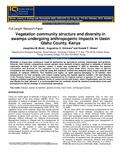| dc.contributor.author | Mulei, Josephine M. | |
| dc.contributor.author | Onkware, Augustino | |
| dc.contributor.author | Otieno, Donald F. | |
| dc.date.accessioned | 2016-06-21T11:58:05Z | |
| dc.date.available | 2016-06-21T11:58:05Z | |
| dc.date.issued | 2016-02 | |
| dc.identifier.issn | 9428 - 167X | |
| dc.identifier.uri | http://repository.rongovarsity.ac.ke/handle/123456789/607 | |
| dc.description.abstract | Wetlands in Kenya face continuous threat of destruction by agricultural activies, urbanization and pollution. However, their floristic compositions remain unkown since research remains restricted to wetlands of national importance because of their touristic values. A
study was conducted in 2006 to determine the species composition and diversity of the vegetation in four swamps within Uasin Gishu County.Data on species composition and diversity were collected using belt transects method and analyzed using cluster analysis and
analysis of variance (ANOVA). Two hundred and eighty six plant species belonging to
70 families were enumerated in the four wetlands, with Leseru swamp having the highest
species number (176) and diversity (4.02). Families Poacea and Asteracea were represented by the highest number of species (41 each). The four swamps exhibited significantly different levels of human activity and impact; where Chepkongony was the most and Marula the least affected. It is recommended that the wetlands should be declared conservation areas and
protected from further drainage or uncontrolled explotation.Keywords: Swamps, species composition, species diversity, Uasin Gishu, anthropogenic factors. | en_US |
| dc.publisher | International Scholars Journals | en_US |
| dc.relation.ispartofseries | African Journal of Ecology and Ecos ystems;Vol. 3 (2 ), pp. 175 - 184 | |
| dc.title | Vegetation community structure and diversity in swamps undergoing anthropogenic impacts in Uasin Gishu County, Kenya | en_US |
| dc.type | Article | en_US |

